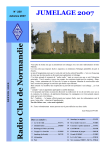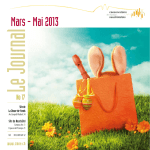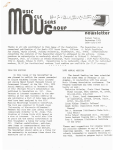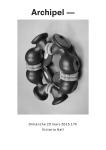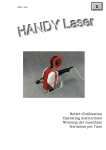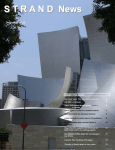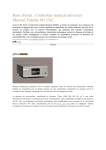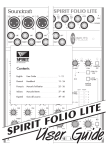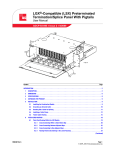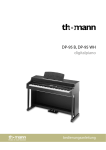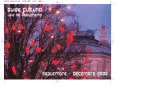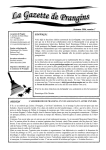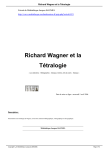Download MOZART PIANO CONCERTOS RONALD BRAUTIGAM
Transcript
MOZART PIANO CONCERTOS Nos 24 in C minor & 25 in C major RONALD BRAUTIGAM DIE KÖLNER AKADEMIE MICHAEL ALEXANDER WILLENS fortepiano MOZART, Wolfgang Amadeus (1756–91) Piano Concerto No. 24 in C minor, K 491 1 2 3 5 6 26'45 12'06 5'58 8'30 Piano Concerto No. 25 in C major, K 503 4 (Bärenreiter) I. Allegro II. Larghetto III. Allegretto I. Allegro maestoso II. Andante III. Allegretto (Bärenreiter) 28'00 13'28 6'08 8'13 Cadenzas: Ronald Brautigam TT: 55'29 Ronald Brautigam fortepiano Die Kölner Akademie Michael Alexander Willens conductor Instrumentarium Fortepiano by Paul McNulty 1992, after an instrument by Anton Walter c. 1795 (see page 23) 2 G randeur comes in many forms. Both concertos on this disc illustrate that fact. In each case Mozart balances the competing claims of structural cohesion, individuality, dramatic dialogue, character contrast, virtuosity and intimacy to achieve something that transcends its generic space. Think of the opening tutti of the C major concerto, K 503, for example. Its straightforward opening military topic is both a gesture and a structure, mapping out the tonic-dominant tonal space in ‘textbook’ fashion, rather like the standard first moves in a chess game. Contained within it, though, is a little bit of individualistic chatter from the winds, introducing the element of dialogue that will become so crucial to the forward flow of this movement. When that chatter turns quickly to the minor mode, we sense that Mozart is signalling in an instant something of the grand scale of this movement, as if one of the chess players had suddenly moved one of his pieces so brilliantly and unexpectedly as to change the landscape of the game entirely, raising the stakes, threatening the security of the ‘textbook’ view. From this moment, the fingerprints all leave a trace of the symphonic. Close-knit contrapuntal interplay among the strings and winds, invertible textures, developmental passages, military references (with a brief nod at revolutionary France, encoded in a hint of La Marseillaise heard as if from afar?)… these are not the expected ingredients of a concerto. The piano enters not with a statement, but in dialogue, its shape emerging as if in improvisation (Mozart had several attempts at perfecting this fantasia-like section as the changing shape of the piano part in a surviving autograph sketch reveals). Only gradually does the triumphant military opening return, with the filigree piano writing at the very top of the range of a fortepiano of Mozart’s time now enhancing those chattering wind figures. From this point on, we begin to realise that this is a concerto after all, within which virtuosity is key. And Mozart achieves yet another balancing act here, because although the solo part 3 is characterised by being virtuosic (and the solo player by being a virtuoso), this is music that does not lack intimacy, moving smoothly and effortlessly between the contrasting worlds of the theatre and the chamber. So the composer is also a virtuoso. Now compare the quiet, brooding opening of K 491 in C minor. Its thematic and tonal space is established tentatively through fragmentary, chromatically swirling shapes lacking any harmonic underpinning at first. Again, the winds break in, defining the structure this time through continuity and contrasting register, rather than witty interplay, and leading to the forceful restatement of the opening theme, whose harmony, thus far withheld, speaks with raging power. While the broadly symphonic nature of the continuation from this point corresponds in its techniques to K 503, the quality of grandeur is quite different. In both movements the winds are defining actors in the drama. But whereas in K 503 they make their gestural and structural contribution largely as a chorus, in K 491 there is a more soloistic contribution, with greater individualistic deployment of woodwind colours. Notably, K 491 (completed in March 1786 and scored for a huge band, for which Mozart needed to purchase especially large, 16-stave manuscript paper) uses clarinets which lend a satisfyingly rounded tone quality to the dialogues, subtly highlighting register contrast when set against the bassoons. (In K 503, there are no clarinets: perhaps no players were available in December 1786, when Mozart completed the piece from a fragment of a C major concerto that had been drafted perhaps as far back as 1784 to judge from the watermarks in the paper of his manuscript; or perhaps he felt that the particularly shrill sound of the C clarinet did not fit his requirements and risked masking the flute and oboe.) As in K 503, the first solo entry in K 491 postpones the expected arrival of the main theme with an interjection of something else; unlike K 503’s fantasia, the piano sets out a measured succes4 sion of phrases, tending increasingly towards the declamatory and culminating in a challenge, thrown down at the orchestra’s feet – to which they respond with an angry restatement of the opening theme. When the piano picks up the threads of this theme and continues an extended process of dialogue we realise that we are in the environment of a concerto once more. The respective slow movements of these two concertos illustrate well the precision of Mozart’s ear for sonority. That of K 503 tends to continue the first movement’s deployment of the winds as a chorus (with beautiful linking of flute and bassoon in double octaves), although there are momentary soloistic touches, a notable example being the imaginative counterpointing of the bassoon against the piano’s line just before the recapitulation of the main theme. While ‘chorus’ woodwind writing is not absent from K 491 (memorably completing a restatement of the main theme by the piano at one point, for instance), one tends to notice the sonority of the clarinets more and more as the work proceeds. That is equally true of the variation finale, one of only two occasions where Mozart uses this form in his piano concertos (the other is K 453 in G). The autograph manuscript of the C minor concerto is an utterly fascinating document. There are multiple revisions to the continuity within the first movement, with curious annotations showing the wholesale repositioning of quite large sections. Mozart’s first thoughts were significantly different from the final narrative, which seems so natural in its flow. In the variation finale there are revisions of a different kind. At one point there are four different versions of the right hand in the solo part (for some of which Mozart needed to write into the – fortunately empty – timpani and trumpet staves in the autograph); not all of these are crossed out, suggesting that the different versions may represent not anything so much as a definitive view, but rather a succession of contrasting provisional possibilities for the player. Elsewhere, we can detect from careful 5 examination of Mozart’s handwriting that the soloist’s right-hand part was at first notated merely in outline sketch, the precise in-filling being in a lighter shade of ink (and not quite properly aligned with the rest of the bar); perhaps Mozart just needed the most basic of cues for such passages in performance, and the details were filled-in afterwards? At any rate, this kind of ‘archaeology’ of Mozart’s creative process suggests that at least a spirit of improvisation inhabited his own performances, and that historically informed performers might attempt something of that same spirit in their approach to these pieces. K 491 was performed on 3rd April 1786 by Mozart himself, and possibly again on 7th April, according to contemporary newspaper reports. It may have been conceived as the final concerto in a set of three including parts for clarinets (the others are K 482 in E flat and K 488 in A). Quite possibly it influenced Beethoven’s third piano concerto in the same key, and soon became a staple of nineteenth-century concert life (Mendelssohn had it in his repertoire through the 1820s and 1830s). K 503 was perhaps completed for performance in one of a series of four Advent concerts held in the Trattner casino in Vienna in early December 1786, although the only documented performance by Mozart himself dates from May 1789 at the Gewandhaus in Leipzig. © John Irving 2011 Ronald Brautigam, one of Holland’s leading musicians, is remarkable not only for his virtuosity and musicality but also for the eclectic nature of his musical interests. He studied in Amsterdam, London and the USA with Rudolf Serkin. In 1984 he was awarded the Nederlandse Muziekprijs, the highest Dutch musical award. 6 Ronald Brautigam performs regularly with leading European orchestras under distinguished conductors such as Riccardo Chailly, Charles Dutoit, Bernard Haitink, Frans Brüggen, Philippe Herreweghe, Christopher Hogwood, Andrew Parrott, Bruno Weil, Iván Fischer and Edo de Waart. In the field of chamber music he has maintained a musical partnership with the violinist Isabelle van Keulen for more than 20 years. Besides his performances on modern instruments Ronald Brautigam has developed a great passion for the fortepiano, appearing with leading orchestras such as the Orchestra of the Eighteenth Century, Tafelmusik, the Orchestra of the Age of Enlightenment, the Hanover Band, Freiburger Barockorchester, Concerto Copenhagen and l’Orchestre des Champs-Elysées. In 1995 Ronald Brautigam began his association with BIS. Among the more than 40 titles released so far are Mendelssohn’s piano concertos (with the Amsterdam Sinfonietta) and, on the fortepiano, the complete piano works of Mozart and Haydn. Also on the fortepiano, Brautigam is currently recording a complete series of the solo piano music by Beethoven, which has been described in the American magazine Fanfare as ‘a Beethoven piano-sonata cycle that challenges the very notion of playing this music on modern instruments, a stylistic paradigm shift.’ His cycle of Beethoven’s piano concertos, on modern piano, has likewise been warmly received, with instalments receiving various distinctions, including a MIDEM Classical Award in 2010. For further information please visit www.ronaldbrautigam.com Based in Cologne, Die Kölner Akademie is a unique ensemble performing music from the seventeenth to the twenty-first centuries on both modern and period instruments with its own choir and world-renowned guest soloists. The ensemble seeks to bring out the composers’ intentions by using historical seat7 ing plans, critical editions and the proper instrumentation for each work. The orchestra has received the highest critical acclaim for its outstanding performances at major international festivals. Many of these performances have been broadcast live and several have been filmed for television. Die Kölner Akademie’s numerous world première recordings have also received awards and high praise. Future plans include tours to Asia and South America. For further information please visit www.koelnerakademie.com Michael Alexander Willens, music director of Die Kölner Akademie, studied conducting with John Nelson at the Juilliard School in New York, where he received B.M. and M.M. degrees. He has also studied with Jacques-Louis Monod, Harold Farberman and Leonard Bernstein at Tanglewood, and choral conducting with Paul Vorwerk. Willens’ broad experience has given him an unusual depth of background and familiarity with performance practice styles ranging from baroque, classical and romantic through to contemporary as well as jazz and pop music. He has conducted concerts at major festivals in Europe and the United States, receiving the highest critical praise, for instance in Gramophone: ‘Willens achieves an impeccably stylish and enjoyable performance’. In addition to standard repertoire, Michael Alexander Willens is dedicated to performing works by lesser-known contemporary American composers and has conducted several world premières, many of which have been broadcast live or filmed for television. He is also keenly interested in bringing neglected music from the past to the fore and has made numerous recordings featuring such works as well as performing them in concert. Besides his commitment to Die Kölner Akademie, Michael Alexander Willens has guest conducted orchestras in Germany, Poland, the Netherlands, Brazil and Israel. 8 G röße zeigt sich in vielerlei Gestalt. Beide Konzerte auf dieser CD demonstrieren diese Tatsache. In beiden Fällen gelingt es Mozart, die konkurrierenden Forderungen nach strukturellem Zusammenhalt, Individualität, dramatischem Dialog, Charakterkontrast, Virtuosität und Intimität auszubalancieren. Und lässt damit das in dieser Gattung Übliche hinter sich. Nehmen wir beispielsweise das Eröffnungs-Tutti des C-Dur-Konzerts KV 503: Sein geradliniger militärischer Habitus zu Beginn ist sowohl Geste wie Struktur, die den Tonika-Dominant-Raum geradezu lehrbuchartig umreißt – ähnlich wie die standardisierten Eröffnungszüge beim Schach. Zugleich aber findet sich darin auch das individuelle Schwatzen der Holzbläser, die jenes dialogische Moment einführen, das für den weiteren Verlauf des Satzes so wichtig werden wird. Indem dieses Schwatzen sich rasch nach Moll wendet, eröffnet Mozart schlagartig den Ausblick auf die erhabene Größe dieses Satzes, so als hätte einer der Schachspieler plötzlich einen so brillanten und unerwarteten Zug getan, dass sich die Landschaft des Spiels gänzlich verändert: Die Einsätze werden erhöht und sichere Lehrbuchmeinungen erschüttert. Von nun an weist alles aufs Symphonische. Dichtes kontrapunktisches Wechselspiel zwischen Streichern und Bläsern, umkehrbare Texturen, Durchführungsabschnitte, militärische Anspielungen (ist eine wie von fern anklingende Andeutung der Marseillaise als kurzer Gruß an das revolutionäre Frankreich gedacht?) … all dies sind keine herkömmlichen Bestandteile der Konzertform. Das Klavier setzt mit einer dialogisch eingebundenen Themenvorstellung ein, die gleichsam aus der Improvisation erwächst. (Wie die wechselnde Gestalt des Klavierparts in einer autographen Skizze zeigt, unternahm Mozart mehrere Versuche, diesen fantasieartigen Teil zu vervollkommnen.) Nur allmählich kehrt die triumphale militärische Einleitung zurück, wobei der filigrane Klaviersatz, der sich im höchsten Register des zu Mozarts Zeit gebräuchlichen Hammer9 klaviers bewegt, nun die schnatternden Bläserfiguren verstärkt. Wir beginnen zu realisieren, dass es sich hier letzten Endes um ein Konzert handelt, so dass die Virtuosität eine zentrale Rolle spielt. Und Mozart gelingt ein weiterer Balanceakt, denn obschon Solopart und Solist sich als virtuos erweisen, fehlt es dieser Musik nicht an Intimität: Geschmeidig und ohne Mühe bewegt sie sich zwischen den kontrastierenden Sphären von Theater und Kammer. Auch der Komponist ist mithin Virtuose. Vergleichen wir damit die ruhige, grüblerische Eröffnung des c-moll-Konzerts KV 491. Sein thematischer und tonaler Raum wird zögernd etabliert; bruchstückhafte, chromatisch wirbelnde Gebilde lassen anfangs jegliche harmonische Fundierung vermissen. Auch hier dringen wieder die Bläser ein, die die Struktur freilich mehr durch Kontinuität und kontrastierende Register als durch witzige Einwürfe prägen. Sie führen zur energischen Restituierung des Eingangsthemas, dessen bislang verhaltene Harmonik nun mit stürmischer Kraft erklingt. Korrespondiert die generell symphonische Anlage des weiteren Verlaufs in ihrer Verfahrensweise dem Konzert KV 503, so definiert sich „Größe“ hier deutlich anders. In beiden Sätzen übernehmen die Bläser wesentliche Rollen. Während sie jedoch in KV 503 ihre gestischen und strukturellen Beiträge weitgehend chorisch liefern, enthält KV 491 mehr solistische Beiträge, wobei namentlich Holzbläserfarben individueller eingesetzt werden. Das Konzert KV 491 (das im März 1786 für ein großes Ensemble fertiggestellt wurde, für das Mozart besonders großes, 16zeiliges Notenpapier kaufen musste) verwendet vor allem Klarinetten, die den Dialogen eine überzeugend abgerundete Klangqualität verleihen und die, gegen die Fagotte eingesetzt, Registerkontraste subtil akzentuieren. (KV 503 sieht keine Klarinetten vor: Vielleicht waren im Dezember 1786 keine Klarinettisten verfügbar, als Mozart das Werk auf der Basis eines C-Dur-Fragments fertigstellte, das 10 aufgrund des Wasserzeichenbefundes vielleicht schon 1784 notiert worden war; vielleicht aber fand er, dass der recht schrille Klang der C-Klarinette seinen Bedürfnissen nicht entsprach und Flöte und Oboe zu verdecken drohte.) Ganz wie in KV 503 zögert auch der Solo-Einsatz in KV 491 den erwarteten Auftritt des Hauptthemas mit einem Einschub ganz anderer Art hinaus; anders aber als die Fantasie in KV 503 erklingt hier eine regelmäßige Phrasenfolge, die zusehends deklamatorischer gerät und in einer dem Orchester hingeworfenen Herausforderung gipfelt, worauf dieses wütend das Eröffnungsthema anstimmt. Sobald das Klavier die Fäden dieses Themas aufgreift und einen ausgedehnten Dialog entfaltet, realisieren wir, dass wir uns wiederum im Umfeld der Konzertform befinden. Die langsamen Sätze dieser beiden Konzerte demonstrieren sehr schön Mozarts Sinn für Klangfarben. Der langsame Satz von KV 503 knüpft in seiner chorischen Verwendung der Bläser an den ersten Satz an (wunderschön sind etwa Flöte und Fagott in Doppeloktaven gekoppelt); unter einigen solistischen Einsprengseln ist besonders die einfallsreiche Art und Weise hervorzuheben, mit der das Fagott die Klavierstimme kurz vor der Reprise des Hauptthemas kontrapunktiert. Obschon auch KV 491 chorische Holzbläser vorsieht (die u.a. einmal das vom Klavier angestimmte Hauptthema einprägsam vervollständigen), so nimmt man den Klarinettenklang im Verlauf des Stückes immer stärker wahr. Das gilt auch für das Variationenfinale, einem von nur zwei Fällen, in denen Mozart diese Form in seinen Klavierkonzerten verwendet (bei dem anderen handelt es sich um das G-Dur-Konzert KV 453). Das autographe Manuskript des c-moll-Konzerts ist ein höchst faszinierendes Dokument. Der Verlauf des ersten Satzes wurde vielfach revidiert, wobei eigenartige Anmerkungen die Neupositionierung großer Teile anzeigen. Mozarts erste Ideen unterscheiden sich erheblich von der Letztfassung, die in ihrem Duktus so natürlich erscheint. Das Variationenfinale zeigt Revisionen anderer 11 Art, u.a. an einer Stelle vier verschiedene Versionen für die rechte Hand des Soloparts (für einige davon musste Mozart die – glücklicherweise leeren – Notenzeilen von Pauke und Trompete benutzen); nicht alle davon sind durchgestrichen, so dass es hier möglicherweise nicht um eine definitive Fassung ging, sondern um eine Reihe kontrastierender vorläufiger Optionen für den Spieler. An anderer Stelle ergibt die sorgsame Untersuchung von Mozarts Handschrift, dass die rechte Hand des Soloparts zuerst als bloßer Rohentwurf notiert wurde, zu dem die konkrete Ausformulierung später in etwas hellerer Tinte hinzukam (und dabei nicht ganz exakt in den Takt eingefügt wurde); vielleicht benötigte Mozart für solche Passagen bei der Aufführung nur die nötigsten Angaben, während die Details später ergänzt wurden? Wie dem auch sei: Diese Art von „Archäologie“ des Mozartschen Schaffensprozesses legt den Gedanken nahe, dass seine Aufführungen zumindest teilweise von improvisatorischem Geist geprägt waren, und dass der Interpretationsansatz historisch informierter Musiker durchaus etwas von jenem Geist beisteuern könnte. Mozart selber spielte sein Konzert KV 491 am 3. April 1786 und vermutlich auch am 7. April, wie zeitgenössische Zeitungen berichten. Es könnte als Abschluss einer Trias von Konzerten mit Klarinettenpartien geplant gewesen sein (die weiteren beiden: Es-Dur KV 482 und A-Dur KV 488). Mit großer Wahrscheinlichkeit beeinflusste es Beethoven Drittes Klavierkonzert, das in derselben Tonart steht, und es gehörte bald zum Kernbestand des Konzertlebens im 19. Jahrhundert (Mendelssohn hatte es in den 1820er und 1830er Jahren im Repertoire). KV 503 wurde möglicherweise für eines der vier Adventskonzerte im Dezember 1786 im Wiener Trattner-Kasino fertiggestellt; die einzige nachweisbare Aufführung mit Mozart am Klavier fand im Mai 1789 im Leipziger Gewandhaus statt. © John Irving 2011 12 Ronald Brautigam, einer der führenden Musiker Hollands, ist nicht nur wegen seiner Virtuosität und Musikalität, sondern auch aufgrund der ungewöhnlichen Vielseitigkeit seiner musikalischen Interessen bemerkenswert. Er hat in Amsterdam, London und den USA (bei Rudolf Serkin) studiert; 1984 wurde er mit dem Nederlandse Muziekprijs, der höchsten musikalischen Auszeichnung in Holland, geehrt. Ronald Brautigam tritt regelmäßig mit den bedeutendsten europäischen Orchestern unter so hervorragenden Dirigenten wie Riccardo Chailly, Charles Dutoit, Bernard Haitink, Frans Brüggen, Philippe Herreweghe, Christopher Hogwood, Andrew Parrott, Bruno Weil, Iván Fischer und Edo de Waart auf. Auf kammermusikalischem Gebiet pflegt er seit mehr als 20 Jahren eine musikalische Partnerschaft mit der Violinistin Isabelle van Keulen. Neben dem Spiel auf modernen Instrumenten hat Ronald Brautigam eine große Leidenschaft für das Fortepiano entwickelt und tritt mit führenden Orchestern wie dem Orchestra of the Eighteenth Century, Tafelmusik, dem Orchestra of the Age of Enlightenment, der Hanover Band, dem Freiburger Barockorchester, Concerto Copenhagen und dem Orchestre des Champs-Elysées auf. 1995 begann Ronald Brautigam seine Zusammenarbeit mit BIS. Zu den mehr als 40 seither veröffentlichten Einspielungen zählen Mendelssohns Klavierkonzerte (mit der Amsterdam Sinfonietta) sowie sämtliche Klavierwerke von Mozart und Haydn, gespielt auf dem Fortepiano. Ebenfalls auf dem Fortepiano nimmt Brautigam derzeit eine Gesamteinspielung der Klaviersolomusik von Beethoven auf; die amerikanische Zeitschrift Fanfare sprach von einem „Beethoven-Klaviersonatenzyklus, der die Annahme, diese Musik sei auf modernen Instrumenten zu spielen, grundsätzlich in Frage stellt: ein stilistischer Paradigmenwechsel.“ Sein Zyklus mit Beethovens Klavierkonzerten auf modernem Klavier wurde ebenfalls mit exzellenten Kritiken bedacht; die sukzessiv erschienenen CDs er13 hielten mehrere Auszeichnungen, u.a. einen MIDEM Classical Award 2010. Weitere Informationen finden Sie auf www.ronaldbrautigam.com Die Kölner Akademie ist ein einzigartiges Ensemble mit Sitz in Köln, das Musik des 17. bis 21. Jahrhunderts auf modernen sowie historischen Instrumenten aufführt – mit eigenem Chor und international renommierten Gastsolisten. Das Ensemble ist bestrebt, sehr nahe an den Vorstellungen des Komponisten zu bleiben, indem es bei jedem Werk historische Sitzordnungen, kritische Editionen und adäquate Besetzungen berücksichtigt. Die Kölner Akademie hat höchste Anerkennung für seine Aufführungen bei bedeutenden internationalen Festivals erhalten. Viele dieser Aufführungen wurden live im Radio gesendet, etliche für das Fernsehen aufgezeichnet. Die zahlreichen Ersteinspielungen der Kölner Akademie sind mit Auszeichnungen und höchstem Lob bedacht worden. Künftige Konzertplanungen beinhalten Tourneen nach Asien und Südamerika. Weitere Informationen finden Sie auf www.koelnerakademie.com Michael Alexander Willens, der Künstlerische Leiter der Kölner Akademie, studierte bei John Nelson an der Juilliard School in New York und schloss mit Auszeichnung ab. Er setzte sein Studium bei Jacques-Louis Monod, Harold Farbermann und Leonard Bernstein in Tanglewood fort. Aufgrund seiner breitgefächerten musikalischen Erfahrung verfügt Michael Alexander Willens über außergewöhnliche Kenntnis und Vertrautheit im Umgang mit Aufführungstraditionen vom Barock über Klassik und Romantik bis hin zur zeitgenössischen Musik sowie der Jazz- und Popmusik. Er hat Konzerte bei bedeutenden Festivals in Europa und den USA dirigiert und dafür höchste Anerkennung erhalten, wie etwa von Gramophone: „Willens gelingt eine unfehlbar stilvolle und erfreuliche Interpretation“. Über das Standardrepertoire hinaus widmet sich Willens 14 der Aufführung von weniger bekannten zeitgenössischen amerikanischen Komponisten. Er hat zahlreiche Uraufführungen dirigiert, von denen viele im Radio ausgestrahlt oder für das Fernsehen aufgezeichnet wurden. Auch der Aufführung und Aufnahme wenig bekannter Werke der Vergangenheit gilt Willens großes Interesse. Als Gastdirigent hat Michael Alexander Willens Orchester in Deutschland, Polen, den Niederlanden, Brasilien und Israel geleitet. 15 L a grandeur se présente sous divers aspects. Les deux concertos que l’on retrouve sur cet enregistrement en font la démonstration. Mozart, dans chacun des cas, équilibre les tendances contraires de cohésion structurelle, d’individualité, de dialogue dramatique, de contraste en ce qui concerne le caractère de virtuosité et d’intimité pour parvenir à quelque chose qui transcende son contexte générique. Prenons par exemple le tutti introductif du Concerto en do majeur K. 503. Son exposition directe et militaire est à la fois un geste et une structure qui établit les grandes lignes de l’espace tonal tonique-dominante d’une manière « littérale », un peu comme l’ouverture traditionnelle d’une partie d’échec. On y retrouve cependant quelque bavardage individualisé aux vents qui introduisent un élément de dialogue qui deviendra bientôt une composante de la propulsion vers l’avant de ce mouvement. Lorsque ce bavardage passe subitement au mode mineur, on sent que Mozart en un instant révèle quelque chose de la grande échelle de ce mouvement, comme si l’un des joueurs d’échec avait soudainement manœuvré ses pièces si brillamment et si soudainement que le paysage de la partie avait entièrement changé, augmenté les enjeux et menacé la sécurité de la « vision » du mode d’emploi. À partir de ce moment, l’empreinte est celle d’une symphonie. Un jeu contrapuntique étroitement tissé entre les cordes et les bois, des textures que l’on peut intervertir, des passages développés, des références militaires (avec une allusion brève à la France de la Révolution codifiée dans un soupçon de Marseillaise entendue comme au loin)… ce ne sont pas là les ingrédients habituels d’un concerto. Le piano entre, non pas avec une affirmation mais dans un dialogue. Il émerge comme dans une improvisation (Mozart a tenté à plusieurs reprises de perfectionner cette section semblable à une fantaisie, ce que révèle les changements dans la partie de piano dans la partition autographe qui nous est parvenue). L’ouverture militaire triomphante ne revient que graduellement avec en 16 filigrane la partie de piano dans le registre suraigu d’un pianoforte de l’époque de Mozart qui amplifie maintenant les motifs semblables à un bavardage aux vents. À partir de cet endroit, on commence à réaliser qu’il s’agit bien après tout d’un concerto dans lequel la virtuosité joue un rôle-clé. Et Mozart parvient à un autre exploit d’équilibriste ici car bien que la partie soliste se caractérise par sa virtuosité (et le soliste par le fait qu’il soit un virtuose), cette musique qui ne manque pas d’intimité se meut en douceur et sans effort entre les univers contrastés du théâtre et de la musique de chambre. Le compositeur est donc lui aussi un virtuose. Prenons maintenant l’ouverture calme et menaçante du K. 491 en do mineur. Son espace thématique et tonal est établi timidement par des formes fragmentaires se déplaçant chromatiquement d’abord sans structure harmonique. Encore une fois, les vents s’interposent et définissent cette fois la structure par un registre continue et contrasté plutôt que par un échange spirituel et mènent à la réexposition avec force du thème introductif dont la structure harmonique, ainsi grandement retenue, s’exprime avec une puissance rageuse. Alors que la nature hautement symphonique du reste du mouvement à partir de cet endroit correspond au niveau technique au K. 503, la qualité de sa grandeur est de nature différente. Dans chacun de ces mouvements, les vents jouent un rôle primordial au sein du drame. Mais alors que dans le K. 503 leur contribution gestuelle et structurelle prend le plus souvent l’apparence d’un chœur, dans le K. 491, leur contribution est davantage de nature solistique avec un plus grand déploiement de couleurs aux bois. Soulignons que dans le K. 491 (terminé en mars 1786 et prévu pour un orchestre de grande dimension et pour lequel Mozart dû s’approvisionner de papier à musique à seize portées), Mozart a recours aux clarinettes ce qui confère une rondeur appréciable aux dialogues soulignant subtilement les contrastes au niveau des registres lorsque mis en opposition avec les bassons. 17 On ne retrouve pas les clarinettes dans le K. 503 : peut-être qu’aucun clarinettiste n’était disponible en décembre 1786 alors que Mozart termina la pièce d’un fragment d’un concerto en do majeur qui avait peut-être été esquissé dès 1784 si l’on en juge par le filigrane du papier du manuscrit. Ou peut-être trouvait-il que la sonorité particulièrement stridente de la clarinette en do ne correspondait pas à ses attentes et risquait de couvrir la flûte et le hautbois. Comme dans le K. 503, la première entrée du soliste dans le K. 491 repousse l’arrivée attendue du thème principal avec l’interjection de quelque chose d’autre. Contrairement à la fantaisie du K. 503, le piano expose une succession mesurée de phrases qui tendent de plus en plus au déclamatoire et qui culminent dans un défi lancé à l’orchestre qui répond avec la réexposition colérique du thème introductif. Lorsque le piano reprend les fils de ce thème et poursuit un processus développé de dialogue, nous réalisons que nous sommes une fois de plus dans l’environnement du concerto. Chacun des mouvements lents de ces deux concertos démontre avec éloquence la précision de l’oreille de Mozart pour la sonorité. Celle du K. 503 tend à poursuivre le déploiement du premier mouvement avec les vents en tant que chœur (avec une superbe association de la flûte et du basson à deux octaves d’intervalle) bien qu’il y ait des touches solistiques momentanées ; le contrepoint imaginatif du basson contre la voix de piano juste avant la récapitulation du thème principal constituant un exemple éloquent. Alors que l’écriture « chorale » des bois n’est pas absente du K. 491 (notamment dans la complétion de la réexposition du thème principal au piano à un endroit précis), on a tendance à remarquer la sonorité des clarinettes au fur et à mesure que l’œuvre progresse. C’est également le cas du finale en variations, l’une des deux fois où Mozart a recouru à cette forme dans un concerto pour piano (l’autre étant dans le K. 453 en sol majeur). 18 Le manuscrit autographe du Concerto en do mineur est un document extrêmement fascinant. On y remarque plusieurs révisions dans la continuité à l’intérieur du premier mouvement, avec de curieuses annotations montrant le repositionnement complet de sections de grande dimension. Les premières idées de Mozart étaient significativement différentes de la narration finale qui nous apparaît si naturelle dans son déroulement. On remarque des révisions de différentes natures dans le finale en variations. On retrouve à un endroit précis quatre versions différentes de la partie pour la main droite de la partie soliste. Mozart fut forcé de les écrire dans les portées – heureusement vides – des timbales et des trompettes dans la partition autographe. Elles ne sont pas toutes biffées ce qui laisserait croire que ces versions différentes pourraient représenter non pas une version définitive mais plutôt une suite de possibilités contrastées à l’usage de l’interprète. Ailleurs dans la partition, on détecte grâce à un examen minutieux de l’écriture de Mozart que la partie de la main droite du soliste fut d’abord une simple esquisse générale alors que l’encre qui a servi au remplissage précis a une couleur plus pâle et n’est pas parfaitement aligné avec le reste de la mesure. Peut-être que Mozart n’avait besoin que d’indications sommaires pour de tels passages lors de l’exécution et que les détails étaient ajoutés après coup. Quoi qu’il en soit, cette « archéologie » du processus créatif de Mozart laisse croire qu’un esprit d’improvisation faisait au moins partie de ses propres exécutions et que les interprètes « historiquement informés » devraient tenter quelque chose dans le même esprit dans leur approche de ces œuvres. Le K. 491 fur exécuté le 3 avril 1786 par Mozart lui-même et probablement à nouveau le 7 avril selon le témoignage d’un quotidien d’alors. Il a pu être conçu comme le concerto final d’une série de trois qui incluait une partie pour les clarinettes (les autres étant le K. 482 en mi bémol majeur et le K. 488 en la majeur). Ce concerto influença probablement le troisième Concerto pour piano 19 de Beethoven qui est dans la même tonalité et qui allait bientôt devenir un cheval de bataille dans la vie musicale du dix-neuvième siècle (Mendelssohn le maintint à son répertoire durant les années 1820 et 1830). Le K. 503 fut peutêtre complété pour une exécution dans le cadre de la série des quatre concerts de l’Avent qui eurent lieu au casino Trattner à Vienne en décembre 1786 bien que la seule exécution par Mozart lui-même qui soit documentée renvoie au Gewandhaus de Leipzig en mai 1789. © John Irving 2011 L’un des éminents musiciens de la Hollande, Ronald Brautigam est remarquable non seulement pour sa virtuosité et sa musicalité mais aussi pour la nature éclectique de ses intérêts en musique. Il a étudié à Amsterdam, Londres et aux Etats-Unis – avec Rudolf Serkin. Il a reçu le plus grand prix musical hollandais en 1984, le Nederlandse Musiekprijs. Ronald Brautigam joue fréquemment avec les meilleurs orchestres européens dirigés par des chefs importants dont Riccardo Chailly, Charles Dutoit, Bernard Haitink, Frans Brüggen, Philippe Herreweghe, Christopher Hogwood, Andrew Parrott, Bruno Weil, Iván Fischer et Edo de Waart. Dans le domaine de la musique de chambre, la violoniste Isabelle van Keulen est sa partenaire musicale depuis plus de 20 ans. En plus de jouer sur des instruments modernes, Ronald Brautigam a développé une grande passion pour le piano-forte, accompagné d’orchestres majeurs dont l’Orchestra of the Eighteenth Century, Tafelmusik, l’Orchestra of the Age of Enlightenment, le Hanover Band, Freiburger Barockorchester, Concerto Copenhagen et l’Orchestre des Champs-Elysées. 20 L’association de Ronald Brautigam avec BIS commença en 1995. Parmi les quarante enregistrements qu’il a réalisés entre 1995 et 2010, on retrouve les concertos pour piano de Mendelssohn (avec la Sinfonietta d’Amsterdam) et, sur piano-forte, toute la musique pour piano solo de Mozart et de Haydn. Brautigam travaille toujours sur un piano-forte pour enregistrer une intégrale de la musique pour piano solo de Beethoven ; à ce sujet, le magazine américain Fanfare écrivit que le « cycle des sonates pour piano de Beethoven met au défi la notion même de jouer cette musique sur des instruments modernes, un paradigme de changement stylistique. » Son intégrale des concertos de Beethoven, sur piano moderne, a également été chaleureusement reçue par la critique alors que les volumes parus ont gagné divers prix dont un MIDEM Classical Award en 2010. Pour de plus amples renseignements, veuillez consulter www.ronaldbrautigam.com Basé à Cologne, le Kölner Akademie est un ensemble unique qui se consacre au répertoire du dix-septième au vingtième siècle, tant sur instruments anciens que sur instruments modernes avec son propre chœur et des solistes de réputation mondiale. L’ensemble s’applique à mettre en évidence les intentions du compositeur par le recours aux plans de salle originaux, aux éditions critiques et à l’instrumentation d’origine pour chaque œuvre. L’orchestre a remporté un énorme succès critique avec ses exécutions exceptionnelles dans le cadre de festivals importants. Plusieurs de ces exécutions ont été radiodiffusées alors que de nombreuses autres ont été filmées pour la télévision. Les créations assurées par le Kölner Akademie se sont également méritée des prix ainsi que les critiques les plus élogieuses. En 2010, les plans de l’orchestre incluaient des tournées en Asie et en Amérique du Sud. Pour de plus amples renseignements, veuillez consulter www.koelnerakademie.com 21 Michael Alexander Willens, directeur musical du Kölner Akademie (2010) a étudié la direction avec John Nelson à la Julliard School à New York. Il a également étudié avec Jacques-Louis Monod, Harold Farberman et Leonard Bernstein à Tanglewood ainsi que la direction de chœur avec Paul Vorwerk. L’expérience variée de Willens lui a procuré une connaissance exceptionnelle des pratiques d’interprétation du répertoire baroque, classique et romantique jusqu’à la musique contemporaine, y compris le jazz et la musique pop. Il a dirigé des concerts dans le cadre des festivals les plus importants d’Europe ainsi qu’aux ÉtatsUnis et a obtenu les meilleurs critiques, notamment dans Gramophone : « Willens parvient à une interprétation impeccablement élégante et attrayante. » En plus du répertoire standard, Michael Alexander Willens se consacre également au répertoire contemporain américain moins connu et a assuré de nombreuses créations dont plusieurs ont été radiodiffusées ou filmées pour la télévision. Il a également abordé avec enthousiasme le répertoire oublié du passé et a réalisé de nombreux enregistrements et dirigé de nombreux concerts consacrés à celui-ci. En plus de son travail avec le Kölner Akademie, Michael Alexander Willens s’est produit à titre de chef invité en Allemagne, en Hollande, au Brésil et en Israël. 22 the instrument used on this recording Anton Walter (1752–1826), who held the title of ‘Imperial Chamber Organ Builder and Instrument Maker’, was the most famous fortepiano maker of his time. He built some 700 instruments, which were praised by Mozart, who bought a Walter in 1782, and by Beethoven, who nearly succeeded in buying one (at a steep discount) in 1802. Born near Stuttgart, Anton Walter became active in Vienna in 1778. When in 1800 his stepson joined the company, the firm name was changed from ‘Anton Walter’ to ‘Anton Walter und Sohn’ The fortepiano used on this recording was made by Paul McNulty 1992, after an instrument by Anton Walter ca. 1795 Compass: FF–g 3 Knee pedals: Sustaining and moderator Furnished in mahogany, French polished Measurements: 221cm/98cm/32cm, 75 kilos 23 Die Kölner Akademie Violin I Violin II Rodolfo Richter leader Frauke Heiwolt Marie-Luise Hartmann Luna Oda Anna-Maria Smerd Bettina Ecken Cecile Dorchene Ingrid Richter Flute Marten Root Oboe Frank de Bruine Alayne Leslie Clarinet Eric Hoeprich Philippe Castejon Bassoon Dana Karmon Flora Padar Viola Klaus Nieschlag Sara Hubrich Horn Rogier Hendrikx Gilbert Camí Farràs Cello Viola de Hoog Julie Maas Trumpet Nicholas Emmerson Andreas Kalthoff Double bass Jacques van der Meer Daniel Zorzano Timpani Ralf Kurley 24 also available Mozart Piano Concertos Concerto No. 9 in E flat major, K 271, ‘Jenamy’ [‘Jeunehomme’] Concerto No. 12 in A major, K 414 · Rondo in A major, K 386 Ronald Brautigam fortepiano Die Kölner Akademie · Michael Alexander Willens conductor BIS-SACD-1794 Editor’s Choice Luister · 5 stelle Musica · Double 5 star review BBC Music Magazine ‘If you prefer your Mozart concertos played on period instruments, you’re unlikely to find better performances than these.’ BBC Music Magazine ‘Brautigam is an absolutely instinctive Mozartian, with… melodic playing of consummate beauty… he has found ideal partners in Michael Alexander Willens and the Kölner Akademie.’ International Record Review „Der Hörer wird Zeuge eines seltenen Glücksfalles perfekter Harmonie: Hier spielt wirklich zusammen, was zusammen gehört.“ Rondo Mozart · Ronald Brautigam fortepiano Complete Sonatas and Variations · BIS-CD-1633/36 (10 CDs for the price of 4) « Si vous aimez le pianoforte et Mozart, ce coffret est un must » ClassicsToday France „der ideale Einstieg in Mozarts Kosmos der Klaviersonaten“ klassik.com ‘for overall artistry, excellent sound quality and cost, go with Brautigam’ Gramophone 25 The music on this Hybrid SACD can be played back in Stereo (CD and SACD) as well as in 5.0 Surround sound (SACD). Our surround sound recordings aim to reproduce the natural sound in a concert venue as faithfully as possible, using the newest technology. In order to do so, all five channels are recorded using the full frequency range, with no separate bass channel added: a so-called 5.0 configuration. If your subwoofer is switched on, however, most systems will also automatically feed the bass signal coming from the other channels into it. In the case of systems with limited bass reproduction, this may be of benefit to your listening experience. 26 RECORDING DATA Recording: Equipment: Post-production: Executive producer: December 2010 at the Immanuelskirche, Wuppertal, Germany Producer: Ingo Petry Sound engineer: Thore Brinkmann Piano technician: Egon Zähringer Neumann microphones; RME Micstasy microphone preamplifier and high resolution A/D converter; MADI optical cabling; Yamaha 02R96 digital mixer; Sequoia Workstation; Pyramix DSD Workstation; B&W Nautilus 802 loudspeakers; STAX headphones Editing: Bastian Schick, Michaela Wiesbeck Mixing: Thore Brinkmann, Ingo Petry Robert Suff BOOKLET AND GRAPHIC DESIGN Cover text: © John Irving 2011 Translations: Horst A. Scholz (German); Jean-Pascal Vachon (French) Typesetting, lay-out: Andrew Barnett, Compact Design Ltd, Saltdean, Brighton, England BIS Records is not responsible for the content or reliability of any external websites whose addresses are published in this booklet. BIS recordings can be ordered from our distributors worldwide. If we have no representation in your country, please contact: BIS Records AB, Stationsvägen 20, SE-184 50 Åkersberga, Sweden Tel.: +46 8 544 102 30 Fax: +46 8 544 102 40 [email protected] www.bis.se BIS-SACD-1894 © & 9 2011, BIS Records AB, Åkersberga. 27 Ronald Brautigam © Marco Borggreve Cover: From Forest to Concert Hall – build your own fortepiano. Step 2: Split a linden tree log, the raw material for the heads of the hammers which strike the strings. Photo: © Fortepiano.eu / Paul McNulty BIS-SACD-1894





























